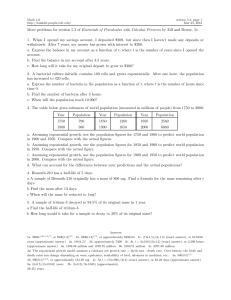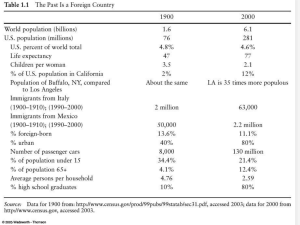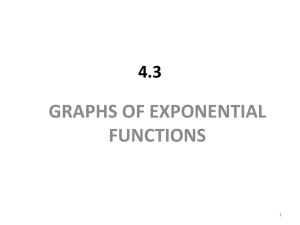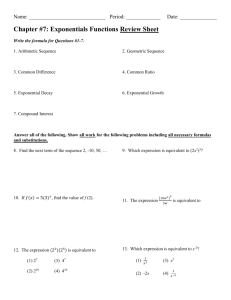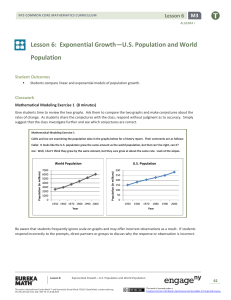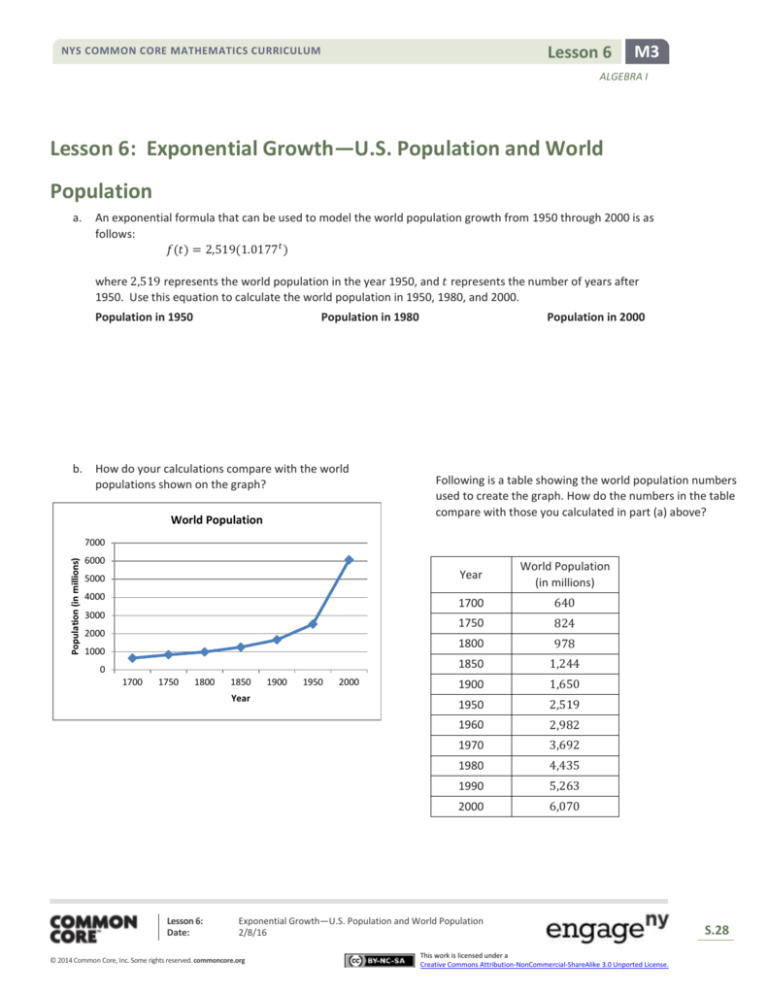
Lesson 6
NYS COMMON CORE MATHEMATICS CURRICULUM
M3
ALGEBRA I
Lesson 6: Exponential Growth—U.S. Population and World
Population
a.
An exponential formula that can be used to model the world population growth from 1950 through 2000 is as
follows:
𝑓(𝑡) = 2,519(1.0177𝑡 )
where 2,519 represents the world population in the year 1950, and 𝑡 represents the number of years after
1950. Use this equation to calculate the world population in 1950, 1980, and 2000.
Population in 1950
b.
Population in 1980
How do your calculations compare with the world
populations shown on the graph?
World Population
Population in 2000
Following is a table showing the world population numbers
used to create the graph. How do the numbers in the table
compare with those you calculated in part (a) above?
Population (in millions)
7000
6000
5000
4000
3000
2000
1000
0
1700
1750
1800
1850
Year
Lesson 6:
Date:
1900
1950
2000
Year
World Population
(in millions)
1700
640
1750
824
1800
978
1850
1,244
1900
1,650
1950
2,519
1960
2,982
1970
3,692
1980
4,435
1990
5,263
2000
6,070
Exponential Growth—U.S. Population and World Population
2/8/16
© 2014 Common Core, Inc. Some rights reserved. commoncore.org
This work is licensed under a
Creative Commons Attribution-NonCommercial-ShareAlike 3.0 Unported License.
S.28
Lesson 6
NYS COMMON CORE MATHEMATICS CURRICULUM
M3
ALGEBRA I
Exercises
1.
The table below represents the population of the U.S. (in millions) for the specified years.
a.
Year
U.S. Population
(in millions)
1800
5
1900
76
2000
282
If we use the data from 1800–2000 to create an exponential equation representing the population, we
generate the following formula for the sequence, where 𝑓(𝑡) represents the U.S. population and 𝑡
represents the number of years after 1800.
𝑓(𝑡) = 5(1.0204)𝑡
Use this formula to determine the population of the U.S. in the year 2010.
b.
If we use the data from 1900–2000 to create an exponential equation that models the population, we
generate the following formula for the sequence, where 𝑓(𝑡) represents the U.S. population and 𝑡
represents the number of years after 1900.
𝑓(𝑡) = 76(1.013)𝑡
Use this formula to determine the population of the U.S. in the year 2010.
c.
The actual U.S. population in the year 2010 was 309 million. Which of the above formulas better
models the U.S. population for the entire span of 1800–2010? Why?
d.
Complete the table below to show projected population figures for the years indicated. Use the
formula from part (b) to determine the numbers.
Year
World Population
(in millions)
2020
2050
2080
Are the population figures you computed reasonable? What other factors need to be considered
when projecting population?
Lesson 6:
Date:
Exponential Growth—U.S. Population and World Population
2/8/16
© 2014 Common Core, Inc. Some rights reserved. commoncore.org
This work is licensed under a
Creative Commons Attribution-NonCommercial-ShareAlike 3.0 Unported License.
S.29
Lesson 6
NYS COMMON CORE MATHEMATICS CURRICULUM
M3
ALGEBRA I
Problem Set
1. The population of the country of Oz was 600,000 in the year 2010. The population is expected to grow by a factor of
5% annually. The annual food supply of Oz is currently sufficient for a population of 700,000 people and is increasing at
a rate which will supply food for an additional 10,000 people per year.
a.
Write a formula to model the population of Oz. Is your formula linear or exponential?
b.
Write a formula to model the food supply. Is the formula linear or exponential?
c.
At what point does the population exceed the food supply? Justify your response.
d.
If Oz doubled its current food supply (to 𝟏. 𝟒 million), would shortages still take place? Explain.
e.
If Oz doubles both its beginning food supply and doubles the rate at which the food supply increases, would
food shortages still take place? Explain.
Lesson 6:
Date:
Exponential Growth—U.S. Population and World Population
2/8/16
© 2014 Common Core, Inc. Some rights reserved. commoncore.org
This work is licensed under a
Creative Commons Attribution-NonCommercial-ShareAlike 3.0 Unported License.
S.30
Lesson 6
NYS COMMON CORE MATHEMATICS CURRICULUM
M3
ALGEBRA I
2. The table below represents the population of the state of New York for the years 1800–2000. Use this information
to answer the questions.
Year
1800
1900
2000
Population
300,000
7,300,000
19,000,000
a.
Using the year 1800 as the base year, an explicit formula for the sequence that models the population of New
York is 𝑃(𝒕) = 𝟑𝟎𝟎𝟎𝟎𝟎(𝟏. 𝟎𝟐𝟏)𝒕 , where 𝒕 is the number of years after 1800.
Using this formula, calculate the projected population of New York in 2010.
b.
Using the year 1900 as the base year, an explicit formula for the sequence that models the population of New
York is 𝑷(𝒕) = 𝟕𝟑𝟎𝟎𝟎𝟎𝟎(𝟏. 𝟎𝟎𝟗𝟔)𝒕 , where 𝒕 is the number of years after 1900.
Using this formula, calculate the projected population of New York in 2010.
c.
Using the internet (or some other source), find the population of the state of New York according to the 2010
census. Which formula yielded a more accurate prediction of the 2010 population?
Lesson 6:
Date:
Exponential Growth—U.S. Population and World Population
2/8/16
© 2014 Common Core, Inc. Some rights reserved. commoncore.org
This work is licensed under a
Creative Commons Attribution-NonCommercial-ShareAlike 3.0 Unported License.
S.31

